Manzanitas (arctostaphylos) are one of my favorite native plants. Their reddish bark offers a striking contrast to their green leaves, which look healthy even when temps start soaring. Very drought tolerant, they grow well in the West as long as you don’t overwater them or fertilize them. The four varieties we’ve planted in our hot front yard are all doing well. Consider planting one since it’s still the best time to plant natives.
Here’s what’s great about them:
Plant characteristics
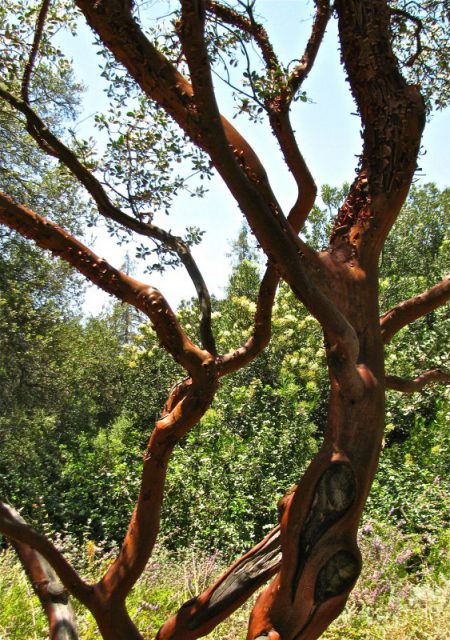
- Gorgeous red to burgundy bark.
- Variety! With 40 types of manzanitas native to California, along with numerous hybrids, you can find short ground cover types and ones that will tower 15 feet or more.
- Their compact leaves range from bright green to gray-green. According to Bart O’Brien of Rancho Santa Ana Botanic Garden, manzanita leaves consistently look good because they’re held perpendicular to the noonday sun to conserve water.
- Flowers are urn-shaped white to pink flowers, with berries in summer/fall.
Habitat value – Wonderful! Their berries feed birds and animals (coyotes love them). Many pollinators, including bumblebees, depend upon mazanitas since their urn-shaped blooms in winter offer a food source during the cold months when few others are available. Hummingbirds also depend on the nectar.
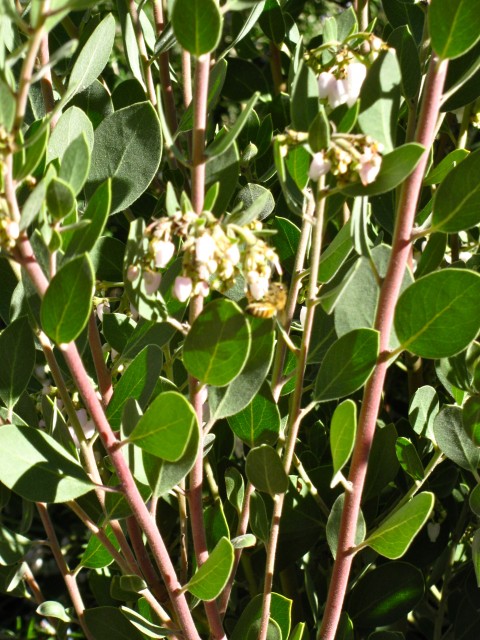
Planting tips – Manzanitas do well in full sun to part shade. The only soils they don’t like are heavy clay and desert sand. Don’t fertilize. A planting tip for all natives is to water heavily when you plant them. Manzanitas are no exception and most varieties won’t need much water after the first year, especially summer water. For dramatic color, Las Pilitas Nursery suggests mixing them with ceanothus (wild lilac) and monkey flowers.
Favorites: Honestly, we haven’t found a manzanita we don’t like. So you really can’t go wrong. These have grown well for us in Southern California or have special characteristics:
LARGE:
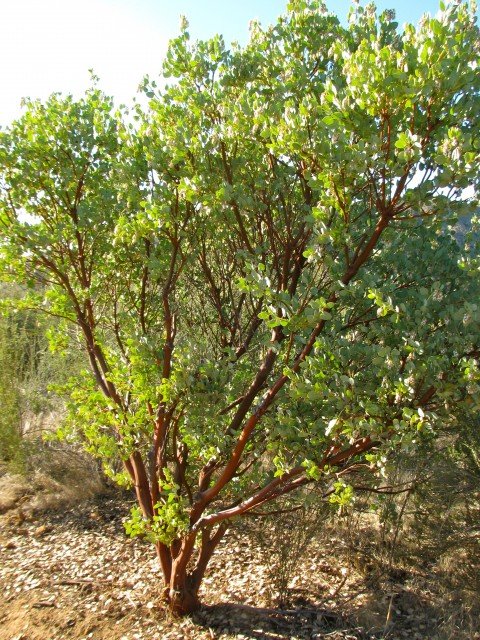
Big Berry Manzanita (Arctostaphylos glauca) is a hardy, large variety that grows 7-10′ foot high and wide. Beautiful red-brown bark with grey-green leaves. Another large (8-10′) and rarer selection is Lester Rowntree Manzanita (6′ by 8′) is named by the woman who collected its seeds from the few remaining manzanitas in the wild. Dr. Hurd is large – 15′ – and makes a nice specimen tree; can handle some summer water. We’e also had great luck with Ray Hartman in full sun.
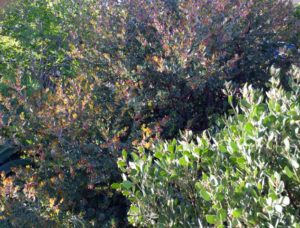
3 year old Lester Rowntree Manzanita at our Redlands CA home – (12 years later it’s 15 feet wide!)
MEDIUM:
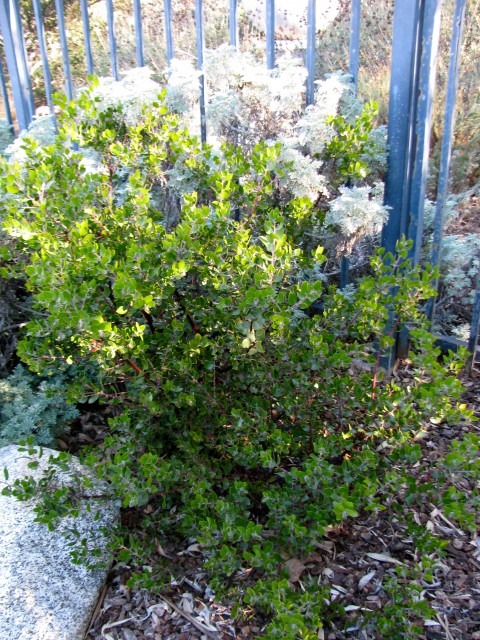
Sunset Manzanita (hybrid of Arctostaphylos hookeri and paroensis) is a nice-looking shrub for smaller areas, growing 3′ high by 4-6′ wide. Features dark red bark, white flowers with a little pink, and bright green leaves. Howard McMinn manzanita (Arctostaphylos “Howard McMinn’ is another popular one that can tolerate regular watering and heavy clay soils. Grows to 8′ but pruning can limit to 5-6′ high and wide.
SMALL:
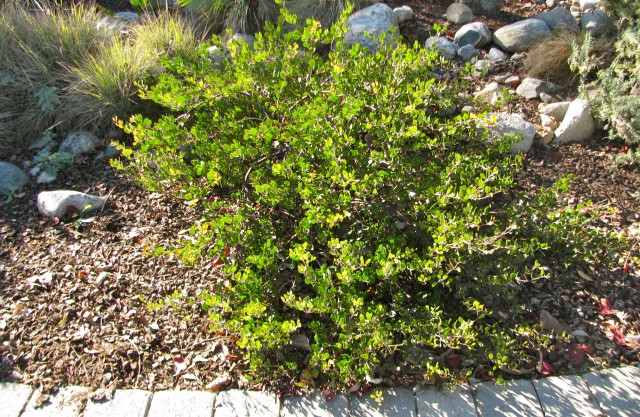
Franciscan manzanita (Arctostaphylos hookeri franciscana)- This unique 2′ by 6′ selection comes from seeds collected years ago for botanic gardens, and now home gardens. Good thing since today it’s endangered, with only one remaining in the wild. Thought extinct, a Franciscan manzanita shrub was spotted by a botanist driving over the Golden Gate Bridge in 2009. Other nice groundcover options include Emerald Carpet (1′ x 4-6′ wide, Carmel Sur, 1-2′ and Pacific Mist (2′).
More info:

Tree of Life Nursery catalog lists plant characteristics for more than 25 varieties of manzanitas
Las Pilitas website for good write-ups of the various manzanitas

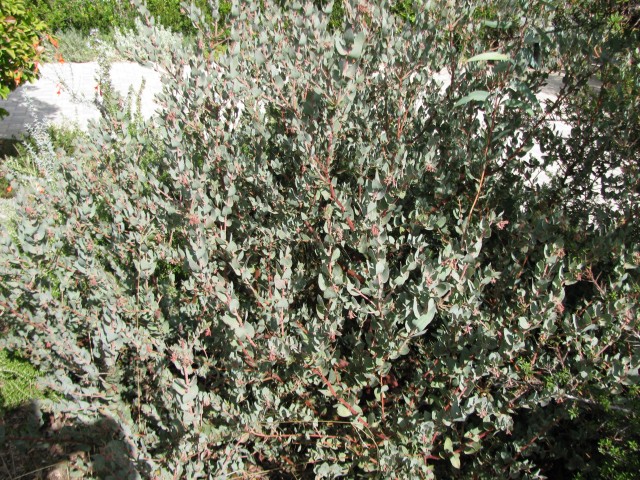
I am in San Diego actually alpine (2,000 feet). So Manzanita is a good choice. I have 2 acres so trying to help with my water bill. I am planting sunset and yankee point ceanothus and I want to add John Dourley but can’t find it anywhere. I have one right now. Love it. Trying to get about four more all to put on a shallow but long bank. What do you think and where can I find it. Plus should I add another for this bank?
We used to live in Alpine! and except for some gopher damage to them, our manzanitas did well. Looked up John Dourley – didn’t know that one – says 5-7 feet wide by 2-3 high – so depends on how long your bank is. In 2009 we planted two manzanitas (Lester Rountree and La Panza, both larger growing) and they’ve now really filled out – 6 feet tall by 5-6 feet wide. Have you tried Kniffings now that Las Pilitas in Escondido closed? Or Tree of Life should have it in San Juan Capistrano. Otherwise not sure, but I bet Kniffings would have some good substitutes. We’ve had so many do well either in Alpine or here in Redlands – aside from the above two, Sunset, Big Berry, Franciscan (rare), and Refugio all have done great – I think you can’t lose with any!